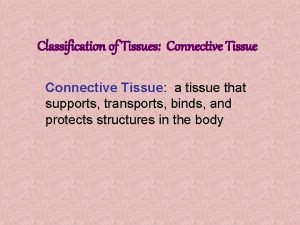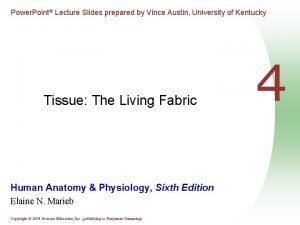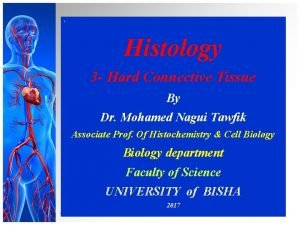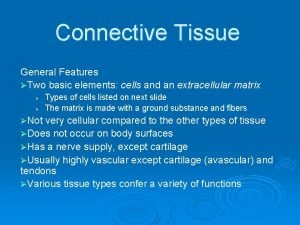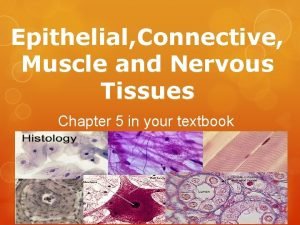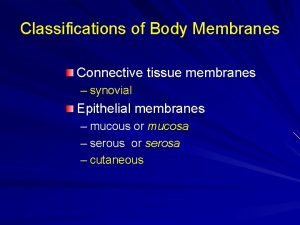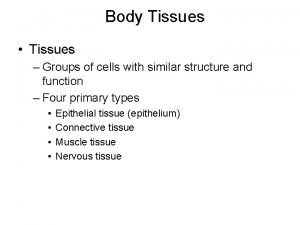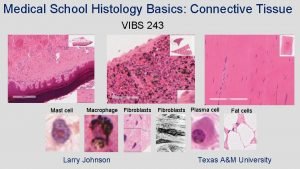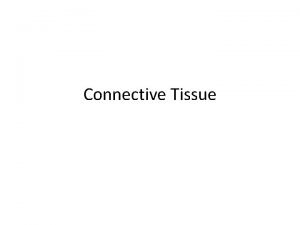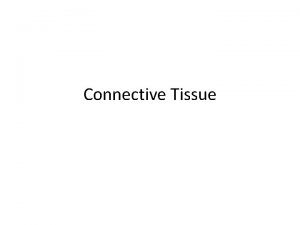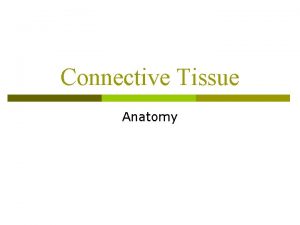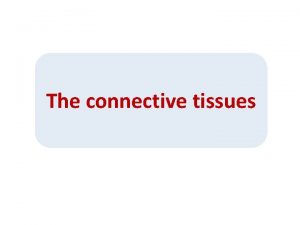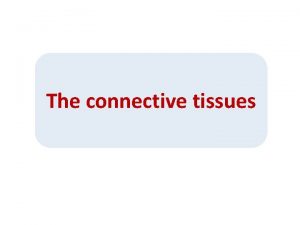Connective Tissue Connective Tissue Connective tissue is found













- Slides: 13

Connective Tissue

Connective Tissue • Connective tissue is found everywhere in the body. It is the most abundant and widely distributed of the primary tissues, but its amount in particular organs varies, • For example, skin consists primarily of connective tissue, while the brain contains very little. • There are four main classes of connective tissue and several subclasses. The main classes are: 1. connective tissue proper (which includes fat and the fibrous tissue of ligaments), 2. cartilage, 3. bone tissue, and 4. blood.

Connective Tissue • Connective tissue does much more than just connect body parts; it has many forms and functions. Its major functions include (1) binding and support, (2) protection, (3) insulation, and as blood, (4) transportation of substances within the body. • For example, bone and cartilage support and protect body organs by providing the hard underpinnings of the skeleton; fat cushions insulate and protect body organs and provide reserve energy fuel.

Common Characteristics of Connective Tissue Despite their many and diverse functions in the body, connective tissues have some common properties that set them apart from other primary tissues: 1. Common origin. All connective tissues arise from mesenchyme (an embryonic tissue) and hence have a common kinship. 2. Degrees of vascularity. Connective tissues run the entire gamut of vascularity. Cartilage is avascular; dense connective tissue is poorly vascularized; and the other types of connective tissue have a rich supply of blood vessels. 3. Extracellular matrix. Whereas all other primary tissues are composed mainly of cells, connective tissues are largely nonliving extracellular matrix (ma′triks; “womb”), which separates, often widely, the living cells of the tissue. Because of its matrix, connective tissue is able to bear weight, withstand great tension, and endure abuses, such as physical trauma and abrasion, that no other tissue would be able to tolerate.


Structural Elements of Connective Tissue • Connective tissues have three main elements: ground substance, fibers, and cells. Ground substance and fibers make up the extracellular matrix. • The properties of the cells and the composition and arrangement of extracellular matrix elements vary tremendously. The result is an amazing diversity of connective tissues, each adapted to perform its specific function in the body. • For example, the matrix can be delicate and fragile to form a soft “packing” around an organ, or it can form “ropes” (tendons and ligaments) of incredible strength.

Ground Substance • Ground substance is the unstructured material that fills the space between the cells and contains the fibers. It is composed of interstitial (tissue) fluid, cell adhesion proteins, and proteoglycans (pro″te-o-gli′kanz). • Cell adhesion proteins (fibronectin, laminin, and others) serve mainly as a connective tissue glue that allows connective tissue cells to attach themselves to matrix elements. • The proteoglycans consist of a protein core to which glycosaminoglycans (GAGs) (gli″kos-ah-me″no-gli′kanz) are attached. GAGs in connective tissues include chondroitin and keratan sulfates and hyaluronic acid (hi″ah-lu-ron′ik).

• Proteoglycan aggregate in cartilage. A schematic drawing of the GAGs keratan sulfate and chondroitin sulfate linked to core protein molecules, forming proteoglycans, which in turn attach to a long hyaluronic acid molecule with the aid of a link protein to form the aggregate.

Fibers • The fibers of connective tissue provide support. • Three types of fibers are found in connective tissue matrix: collagen, elastic, and reticular fibers. Of these, collagen fibers are by far the strongest and most abundant. 1. Collagen fibers are constructed primarily of the fibrous protein collagen. 2. Elastic fibers are long, thin fibers that form branching networks in the extracellular matrix, contain a rubberlike protein, elastin, can stretch only so much before its thick, ropelike collagen fibers become taut. 3. Reticular fibers are short, fine, collagenous fibers (with a slightly different chemistry and form) and are continuous with collagen fibers. They branch extensively, forming delicate networks (reticul = network) that surround small blood vessels and support the soft tissue of organs.

Cells • Each major class of connective tissue has a fundamental cell type that exists in immature and mature forms • The undifferentiated cells, indicated by the suffix blast (literally, “bud” or “sprout, ” but the suffix means “forming”), • The primary blast cell types by connective tissue class are (1) connective tissue proper: fibroblast; (2) cartilage: chondroblast (kon′dro-blast″); (3)bone: osteoblast (os′te-o-blast″); and (4) blood: hematopoietic stem cell (hem″ah-to-poy-et′ik).


Cells • Additionally, connective tissue is home to an assortment of other cell types, such as nutrient-storing fat cells and mobile cells that migrate into the connective tissue matrix from the bloodstream. The latter include defensive white blood cells (neutrophils, eosinophils, lymphocytes) and other cell types concerned with tissue response to injury, such as mast cells, macrophages (mak′ro-fāj-es), and antibodyproducing plasma cells.

• A prototype (model) connective tissue.


